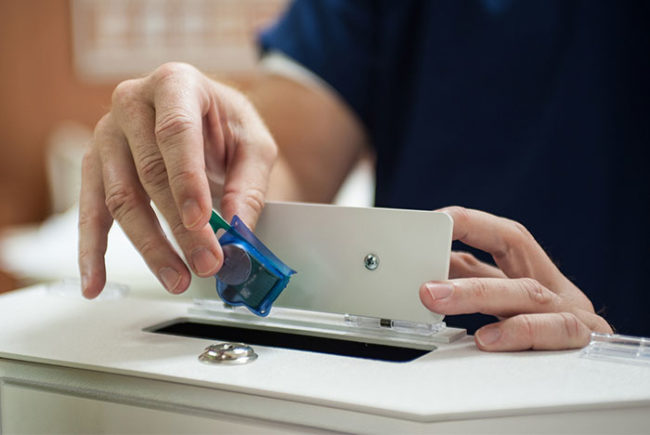
Image courtesy of Zebra Technologies
Real-time location systems (RTLSs), also known as real-time locating systems, are growing rapidly in hospitals. They are most often used to track the location of mobile medical equipment to help reduce search time and rental equipment dependency. This helps prevent loss and provides data-backed insights that can help decrease capital replacement costs.
Improving worker safety is another benefit. RTLS tags can serve as wearable, personal alarms that show exactly where a vulnerable employee is located, triggering swift intervention by colleagues and security personnel. If an employee is in a dangerous situation, the push of a button can transmit the employee’s location directly to security.
Infant security and finding wandering patients are other applications. These deployments have evolved to include integration with related security systems, such as video and alarm management, to provide better security coverage.
Asset visibility is being expanded to applications such as sterile process management and tray tracking. Environmental monitoring is another RTLS application.
Additionally, while known for hospitalwide uses, RTLSs also have a role in smaller, off-site health care facilities because of their scalability.
For example, Midmark RTLS, Traverse City, Mich., is working with health care systems to extend staff duress functionality to ambulatory facilities, according to Jennifer White Kuysten, senior marketing and business development manager. “In addition to enhancing safety, hospitals have used RTLS in clinics to improve patient flow and to track key metrics such as patient wait time and time with providers.”
Smart technology
Recent advances in RTLS technology are connected to artificial intelligence (AI) and the Internet of Things (IoT). In fact, the roots of RTLS in clinical care go back to the early 2000s, according to Kenny Woods, senior vice president of sales and professional services at CenTrak, Newtown, Pa.
“At that time, the systems were sensors on the edge of the network, sending back critical data for location information,” Woods says. “Today, we have real-time intel coming in for assets, patients and staff, and we can integrate with electronic health records and clinical data.”
Machine learning is a game changer for RTLS in that it leads to decreased hardware and software costs and increased accuracy, according to Philipp Wehn, vice president of innovation and strategy at Enlighted, A Siemens Company, Santa Clara, Calif. “At its core, RTLS is about time series data. At its simplest, it is about data movement correlated with an asset location at different points in time. However, it’s the ability to associate with a wealth of other information within a hospital and perform modeling and analysis where the real value emerges.”
AI and IoT solutions will continue to grow as they relate to RTLS, says Matt Crane, chief commercial officer for North America at Sonitor Technologies, Greenwich, Conn. He sees significant opportunity in moving large amounts of locating data to the cloud so that it can be analyzed by AI.
“We also see common devices, such as mobile phones and tablets, contributing to the future of locating solutions,” Crane says. “The leaders in health care RTLS will be the ones to design solutions that leverage infrastructure and devices already owned by the provider to create a more affordable and accurate location solution that delivers data to the cloud for AI purposes.”
How can data from RTLS be used to improve the performance of hospitals and off-site health care facilities? To use the data from RTLS to improve performance, it’s important to have a scalable, enterprise-grade platform that can support one or multiple locations and can manage many applications in a centralized place, according to vendors.
Recent introductions
RTLSs recently introduced to the health care market incorporate many of these features. Following the development of its Engage consulting services, CenTrak, Newtown, Pa., has introduced the Engage IQ platform.
“Engage IQ grants easy, intuitive access for RTLS users, removing the barriers that prevent many organizations from leveraging modern analytics to their full potential,” Woods says. “The platform can be used to solve one-off problems or be implemented as an enterprise-wide business intelligence platform. Engage IQ leverages machine learning and predictive AI to maximize real-time technologies in hospitals.”
To guarantee the best outcomes for patients and facilities, Engage IQ automates operations while using machine learning for continuous process improvement. “For example, when integrated with our environmental monitoring offerings, the system provides continuous diagnostic reports on refrigerator and freezer temperatures,” Woods says. “The system then leverages the historical data to generate predictive analytics that define when the refrigerator or freezer will fail. It can run daily checks and alert the staff prior to any equipment failure.”
Vizzia Technologies, Atlanta, has upgraded its InVIEW software platform, which provides real-time data analytics and reports designed to improve patient care.
“InVIEW offers a faster, more secure, cloud-based experience, with powerful analytics and new maps,” says Dave Wiedman, chief commercial officer. “The platform utilizes proprietary algorithms to analyze more than 1 million data events daily and generates actionable alerts for med techs and nurses. It leverages 15 years of ‘go-live’ experience with hospitals and clinics nationwide.”
According to Wiedman, patient workflow solutions are the fastest growing applications as clinicians look to leverage RTLS to improve patient care. Wiedman notes that Vizzia has collaborated with doctors and nurses to create StrokeStat, an RTLS stroke monitoring solution that optimizes the treatment workflow for acute stroke patients.
Midmark RTLS has added Bluetooth Low Energy (BLE) locating technology and cloud-based software to help modernize hospital asset tracking and staff duress systems. The company’s BLE sensors can be deployed quickly without the disruption that other technologies create, allowing patient care units to remain active, according to Kuysten.
“BLE has better accuracy than Wi-Fi-based locating systems,” Kuysten says. “Cloud-based software, in addition to the BLE Sensory Network, enables easy scalability across multiple facilities in a health care system and many integration possibilities.”
Stanley Healthcare, now Securitas Healthcare and part of Securitas, Portsmouth, N.H., has introduced the BLE Asset Tag, a component of its BLE and MobileView platform. The device allows hospitals to track, manage and protect critical mobile medical equipment. In turn, this increases asset utilization, drives patient safety and reduces costs.
The small form factor, high-impact tag with long battery life adds flexibility and scalability to track assets across a wide variety of applications and can support third-party tags, according to Bob Metzler, director of product management. The tag supports BLE 5.0 and can be quickly activated via push-button. “With five years of experience utilizing BLE technology and hundreds of installs, we were excited to bring this technology to MobileView,” Metzler says.
Other innovations
GE HealthCare, Chicago, has added “room history” to its Encompass RTLS, which allows users to view, on a timeline, what mobile medical assets came into a room and for what duration. Room history has various applications, all based on the idea of asset management and operational improvement.
“Another new feature of Encompass released to the health care market is a series of application programming interfaces that allow for a vendor-agnostic [computerized maintenance management system] integration,” says Mohamed El-Demerdash, president for U.S. and Canada services at GE HealthCare.
AiRISTA, Sparks, Md., has introduced a wireless gateway RTLS that implements BLE angle of arrival, which uses a series of micro-antenna to achieve submeter location accuracy and the ability to track in the vertical dimension. This extends the applications supported by BLE to areas such as stock rooms and inventory accounting.
“We recently added BLE high-accuracy distance measurement to the gateway, eliminating the need for multiple measurement points performing trilateration; hence, a single device can now provide submeter accuracy determination,” says Vince Grove, vice president of marketing.
GuardRFID Solutions, Vancouver, B.C., Canada, offers various RTLS solutions on its AllGuard platform: “Staff duress,” designed to protect hospital staff, features a wireless rechargeable tag with a push-button alarm and utilizes a hospital’s existing Wi-Fi infrastructure; “infant security” features small, lightweight active radio-frequency identification (RFID) tags; and “wandering patient” provides tamper-proof tags that can be configured to trigger alarms and door access. “GuardRFID is working with hospitals to help provide a safer environment for staff and patients,” says Kerry Brock, president and chief revenue officer.
Kontakt.io, Charleston, S.C., has introduced indoor location services that are based on open-source standards, such as BLE, Wi-Fi and cloud computing. Key features include scalability (users start with a basic offering and increase performance over multiple phases as needed); ease of deployment and installation in two to three weeks; and cost savings due to minimal labor required during installation.
“To meet hospital demands, we developed specialized IoT and location sensors, and a self-learning location engine with a web-based, end-user interface that addresses specific health care use cases,” says Kapil Asher, health care practice lead.
Sonitor Technologies Inc. offers Sonitor Sense RTLS badges, which complement dispensers enabled by its SenseClean hand-hygiene modules. The badges automatically capture the number of dispenses from a specific dispenser as well as battery lifetime status. This data, along with the association of which staff member triggered the event, allows facilities managers to accurately monitor compliance.
Zebra Technologies, Lincolnshire, Ill., offers hardware and software solutions that are designed to drive RTLS solutions in the health care market.
“We understand that one location technology does not fit all applications and have built our software to seamlessly utilize the best one for the task at hand,” says McLeod Williamson, Intelligent Edge RFID solutions specialist at Zebra. “Our software shares location data broadly to other systems that can benefit from it, allowing hospitals to choose the right dashboards and reporting tools for their individual use cases. This enterprise-wide location data can provide numerous benefits within a health care system.”
Enlighted, A Siemens Company, offers the Location Intelligence solution, which is based on the company’s lighting and IoT data system.
“We start with continuously powered sensors embedded in lighting fixtures operating over a wireless network, driving occupancy-based lighting and heating intelligence for energy cost savings,” Wehn explains. “Hospitals are thus blanketed with a data gathering and sensing system that also can track assets, patients and staff. Leveraging tags and badges, together with the data collected by our lighting sensors, provide a variety of RTLS applications within hospitals.”
User-friendly future
RTLS will be increasingly used to help address key issues within the health care field, including the labor shortage and increased frequency of violent events during the pandemic, Metzler predicts.
“Advances in RTLS technology will see hospital staff badges become more user-friendly and the introduction of software suites that prioritize individual staff members,” he says.
Kuysten says the future of RTLS in hospitals lies in the simplicity of cloud delivery models: extending the cloud-based platform and easy-to-deploy BLE technology to deliver RTLS benefits that can quickly and seamlessly provide a full range of benefits across the entire health system.

EASY READING
The RFD40 radio-frequency identification reader improves visibility and traceability of medical supplies. Zebra Technologies

A CLOSE EYE
The InVIEW RTLS software engine provides a 360-degree look at a hospital system’s most important staff and assets. Vizzia Technologies

TAG, YOU’RE IT
The T2s tag provides room-level accuracy and real-time notifications. Stanley Healthcare, now Securitas Healthcare

CONSTANT CONTACT
With SmartTag technology, changes in location of people and equipment are transmitted instantly over a facility’s Wi-Fi network. Sonitor Technologies

MULTIFUNCTIONAL
The AllGuard platform offers staff duress, asset tracking, infant security and temperature monitoring functions. GuardRFID Solutions

BETTER VIEW
This RTLS cloud-based asset tracking enables staff to improve patient care through better asset visibility. Midmark RTLS

SAFE AT WORK
This staff safety solution provides various stakeholders with a 24/7/365 view of what’s happening in their facility in real time. Kontakt.io

CONTROLLING CAPITAL
Encompass helps hospitals manage mobile asset inventory, reduce total cost of ownership and achieve better capital allocation. GE HealthCare

SMART TRACKING
Location Intelligence leverages an infrastructure of lighting-based sensors for energy savings, efficient workflows and asset tracking. Enlighted, A Siemens Company

QUICK RESPONSE
This staff duress solution utilizes real-time location technology to increase response times to staff emergencies. CenTrak
Neal Lorenzi is a Mundelein, Ill.-based contributor to Health Facilities Management.






